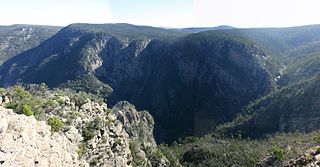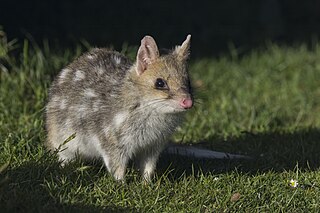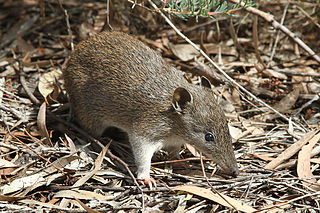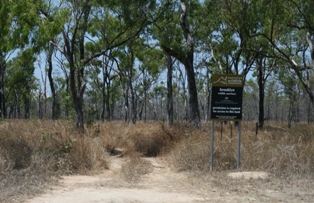
The Sturt National Park is a protected national park that is located in the arid far north-western corner of New South Wales, in eastern Australia. The 325,329-hectare (803,910-acre) national park is situated approximately 1,060 kilometres (660 mi) northwest of Sydney and the nearest town is Tibooburra, 6 kilometres (3.7 mi) away.

The Snowy River National Park is a national park located in the Alpine and East Gippsland regions of Victoria, Australia. The 98,700-hectare (244,000-acre) national park is situated approximately 390 kilometres (240 mi) northeast of Melbourne and 350 kilometres (220 mi) southwest of Canberra, south of the Black-Allan Line that marks part of the border between Victoria and New South Wales.

Quolls are carnivorous marsupials native to Australia and New Guinea. They are primarily nocturnal and spend most of the day in a den. Of the six species of quoll, four are found in Australia and two in New Guinea. Another two species are known from fossil remains in Pliocene and Pleistocene deposits in Queensland. Genetic evidence indicates that quolls evolved around 15 million years ago in the Miocene, and that the ancestors of the six species had all diverged by around four million years ago. The six species vary in weight and size, from 300 g (11 oz) to 7 kg (15 lb). They have brown or black fur and pink noses. They are largely solitary, but come together for a few social interactions such as mating which occurs during the winter season. A female gives birth to up to 30 pups, but the number that can be raised to adulthood is limited by the number of teats (6–7). They have a life span of 1–5 years.

The eastern barred bandicoot is a nocturnal, rabbit-sized marsupial endemic to southeastern Australia, being native to the island of Tasmania and mainland Victoria. It is one of three surviving bandicoot species in the genus Perameles. It is distinguishable from its partially-sympatric congener – the long-nosed bandicoot – via three or four dark horizontal bars found on its rump. In Tasmania, it is relatively abundant. The mainland population in Victoria is struggling and is subject to ongoing conservation endeavors.

The eastern quoll is a medium-sized carnivorous marsupial (dasyurid), and one of six extant species of quolls. Endemic to Australia, they occur on the island state of Tasmania, but were considered extinct on the mainland after 1963. The species has been reintroduced to fox-proof fenced sanctuaries in Victoria in 2003 and to the Australian Capital Territory in 2016.

The western quoll is Western Australia's largest endemic mammalian carnivore. One of the many marsupial mammals native to Australia, it is also known as the chuditch. The species is currently classed as near-threatened.

The southern brown bandicoot is a short-nosed bandicoot, a type of marsupial, found mostly in southern Australia. A subspecies in Western Australia was also known as the quenda in South Western Australia. This subspecies was elevated to species in 2018.

The golden bandicoot is a short-nosed bandicoot found in northern Australia. It is the smallest of its genus, and is distinguished from the brown bandicoots by its golden colouring and much smaller size.

The Western barred bandicoot, also known as the Shark Bay bandicoot or the Marl, is a small species of bandicoot; now extinct across most of its former range, the western barred bandicoot only survives on offshore islands and in fenced sanctuaries on the mainland.

Mornington Sanctuary, formerly Mornington Station, is a 3,582 km2 (1,383 sq mi) nature reserve in the Kimberley region of north-west Western Australia. It contains the Mornington Wilderness Camp and is owned and managed by the Australian Wildlife Conservancy (AWC). It lies in the Pentecost subregion of the Central Kimberley Bioregion.

Serendip Sanctuary is a 250 ha protected area in Victoria, Australia, near the You Yangs and the town of Lara, some 22 km (14 mi) north of Geelong and 60 km (37 mi) south-west of Melbourne. Originally used for farming and other purposes, it was purchased in 1959 by the State Government of Victoria for wildlife research and the captive management and breeding of species threatened in Victoria, such as the brolga, magpie goose, Australian bustard, and bush stone-curlew. The sanctuary contains many different types of wetland and is home to many plant species as well, such as river red gums, tall spikerush, and tussock grass. Serendip now focuses more on environmental education about the flora and fauna of the wetlands and open grassy woodlands of the Volcanic Western Plains of Victoria. It was opened to the public in 1991 and is now managed by Parks Victoria.
Dr John Wamsley is an Australian environmentalist. He was the Prime Minister's Environmentalist of the Year for 2003. Wamsley is known for his attempt to set up a network of wildlife sanctuaries across Australia.

The Australian Wildlife Conservancy (AWC) is an independent Australian nonprofit organisation, working to conserve threatened wildlife and ecosystems in Australia. AWC is the largest private owner and manager of land for conservation in Australia, currently managing 31 sanctuaries and partnership sites for wildlife conservation that cover over 6.5 million hectares of land across Australia. It partners with governmental agencies, Indigenous groups, and private landholders to manage landscapes for effective conservation. Most funding comes from private support in the form of tax-deductible donations from the public, as well as some government grants for particular purposes, such as from the Australian government's National Reserve System Program.

Brooklyn Sanctuary is a 600 km2 (232 sq mi) nature reserve in north-east Queensland, Australia, less than 100 km (62 mi) north-west of Cairns. It is owned and managed by the Australian Wildlife Conservancy by which it was acquired in 2004. It is located on the boundary of the Wet Tropics bioregion and Einasleigh Uplands bioregion on the Mount Carbine Tableland. The landscape varies widely from rugged, rainforested peaks of up to 1,200 m altitude, with an annual rainfall of 4,000 mm, to drier lowland plains in the upper reaches of the Mitchell River with less than 900 mm. It is important for the conservation of upland endemic species. Part of the property is inscribed on the World Heritage List.

Mount Gibson Sanctuary is a 1,305-square-kilometre (504 sq mi) nature reserve on the northern edge of the Wheatbelt and the southern margin of uncleared rangeland country, 350 kilometres (220 mi) north-east of Perth in mid-west Western Australia. The nearest large town is Dalwallinu. It is in the Avon-Wheatbelt Bioregion and is owned and managed by the Australian Wildlife Conservancy (AWC).

Mulligans Flat Woodland Sanctuary is a protected area situated in the Gungahlin district in north Canberra in the Australian Capital Territory. It has several trails for walking, running and cycling. The sanctuary functions as a fieldwork site for researchers studying native ecology.
Pungalina-Seven Emu Sanctuary is a 3060 km2 private protected area in the Northern Territory of Australia. It is managed by the Australian Wildlife Conservancy (AWC) which purchased Pungalina Station in 2009, with some assistance from the Wildlife Australia Fund. It adjoins the Gulf of Carpentaria near the border with Queensland, lying in the Gulf Coastal bioregion. The reserve is bordered by Calvert Hills and Wollogorang Stations to the south and east. The nearest town is Borroloola, 150 km to the west.
Charnley River–Artesian Range Wildlife Sanctuary is a protected area covering about 3,000 square kilometres (1,200 sq mi) in the Kimberley region of Western Australia. It is situated about 205 kilometres (127 mi) east of Derby and 287 kilometres (178 mi) north west of Halls Creek, and is accessed via the Gibb River Road. It is named after the Charnley River that flows through the property.
Mount Rothwell is a locality in Victoria, Australia, located to the north east of the You Yangs hills, between Bacchus Marsh and Werribee.
Nigel Sharp is an Australian conservationist and biodiversity impact investor known for his work on the continent of Australia with threatened species conservation, new business models of regenerative agriculture and urbanism, nature-based tourism, and indigenous enterprise development.













